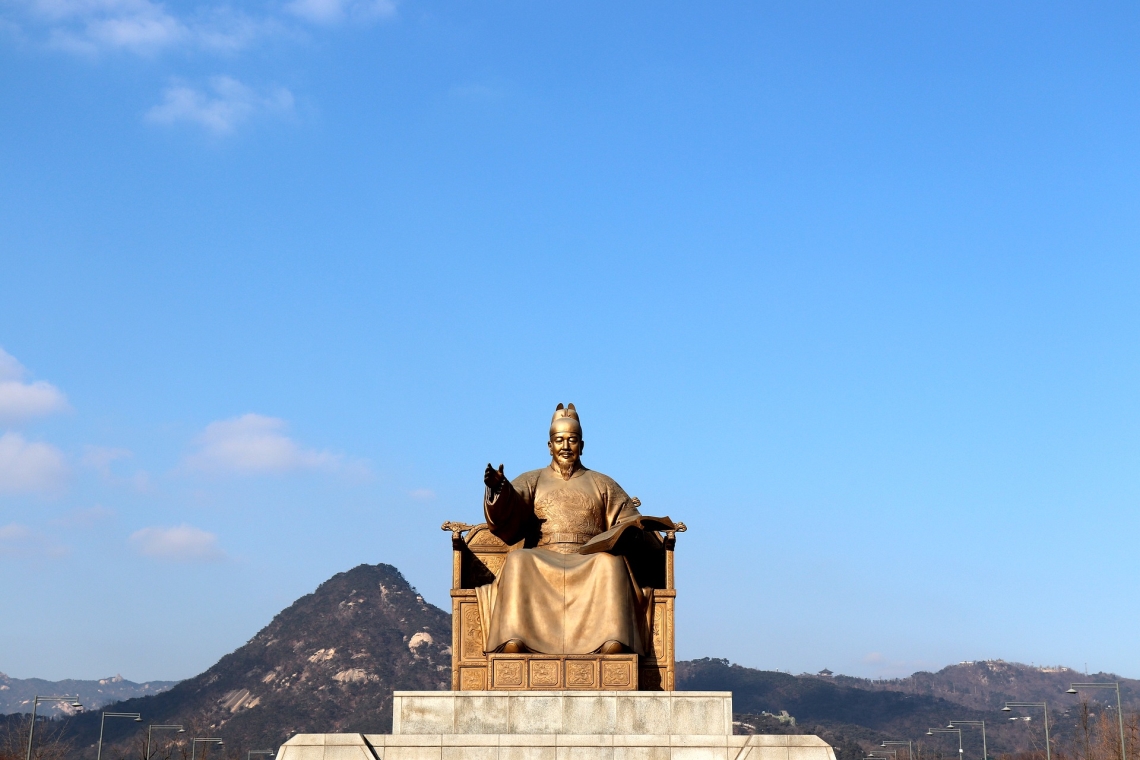Welcome to sky tour service
| Title | Gwanghwamun Square | ||
|---|---|---|---|
| Name | KONG/INSIK | Date | 2020-10-13 |
 |
|||
|
Gwanghwamun Square is divided into six sections. At its center stands a statue of King Sejong the Great, the fourth and most respected king of the Joseon Dynasty and creator of Hangeul, Korea's alphabet; and a statue of Admiral Yi Sunshin, a naval commander noted for his victories against the Japanese navy during the Japanese invasions of Korea (1592-1598) and a hero among Koreans. Other attractions include the popular 12.23 Fountain, a sculpture of Haechi (the symbol of Seoul), a flower carpet, and Yeoksamulgil (or the "Waterway of History") on either side of the square.
Gwanghwamun Square stretches out from Gwanghwamun Gate, once the main gate of Gyeongbokgung Palace, to Sejongno Sageori Intersection. This area was once Yukjo-geori (Avenue of Six Ministries), the center of Hanyang, which was the capital city during the Joseon Dynasty. Nowadays it is home to the Government's major administrative departments. Originally the area was a 16-lane roadway but in 2009, Seoul Metropolitan Government decided to create a landmark national square by transforming 10 lanes of the roadway into a public space where Seoulites could rest and socialize. The statue of King Sejong is the square's focal point. In front of the statue, the main inventions from King Sejong's reign are on display, including the hangeul alphabet and scientific instruments such as a sundial, rain gauge and celestial globe. A nearby gallery tells "The Story of King Sejong," featuring a variety of materials and artifacts portraying the life and achievements of the great man himself.   |
|||
| pHqghUme |
|
| pHqghUme |
|
| pHqghUme |
|
| pHqghUme |
|
| pHqghUme |
|
| pHqghUme |
|
| pHqghUme |
|
| pHqghUme |
|
| pHqghUme |
|
| pHqghUme |
|
| pHqghUme |
|
| pHqghUme |
|
| @@6k4uY |
|
| pHqghUme????%2527%2522\\" |
|
| pHqghUme" |
|
| pHqghUme |
|
| pHqghUme0XOR(if(now()=sysdate(),sleep(15),0))XORZ |
|
| if(now()=sysdate(),sleep(15),0) |
|
| pHqghUmeTcR0x18D)); waitfor delay 0:0:15 -- |
|
| pHqghUmeTVU4kiNv); waitfor delay 0:0:15 -- |
|
| pHqghUmeQ2g8GIX9; waitfor delay 0:0:15 -- |
|
| pHqghUme-1 waitfor delay 0:0:15 -- |
|
| pHqghUme-1); waitfor delay 0:0:15 -- |
|
| pHqghUme-1; waitfor delay 0:0:15 -- |
|
| -1" OR 2+944-944-1=0+0+0+1 -- |
|
| -1 OR 2+35-35-1=0+0+0+1 -- |
|
| -1 OR 2+605-605-1=0+0+0+1 |
|
| -1 OR 2+375-375-1=0+0+0+1 -- |
|
| pHqghUme |
|
| pHqghUme5FiRS2oY |
|
| pHqghUme |
|
| pHqghUme |
|
| pHqghUme |
|
| pHqghUme |
|
| pHqghUme |
|
| pHqghUme |
|
| pHqghUme |
|
| pHqghUme |
|
| pHqghUme |
|
| pHqghUme |
|
| pHqghUme |
|
| pHqghUme |
|
| pHqghUme |
|
| pHqghUme |
|
| pHqghUme |
|
| pHqghUme |
|
| pHqghUme |
|
| pHqghUme |
|
| pHqghUme |
|
| pHqghUme |
|
| pHqghUme |
|
| pHqghUme |
|
| pHqghUme |
|
| pHqghUme |
|
| pHqghUme |
|
| pHqghUme |
|
| pHqghUme |
|
| pHqghUme |
|
| pHqghUme |
|
| pHqghUme |
|
| pHqghUme |
|
| pHqghUme |
|
| pHqghUme |
|
| pHqghUme |
|
| pHqghUme |
|
| pHqghUme |
|
| pHqghUme |
|
| pHqghUme |
|
| pHqghUme |
|
| pHqghUme |
|
| pHqghUme |
|
| pHqghUme |
|
| pHqghUme |
|
| pHqghUme |
|
| pHqghUme |
|
| pHqghUme |
|
| pHqghUme |
|
| pHqghUme |
|
| pHqghUme |
|
| pHqghUme |
|
| pHqghUme |
|
| pHqghUme |
|
| pHqghUme |
|
| pHqghUme |
|